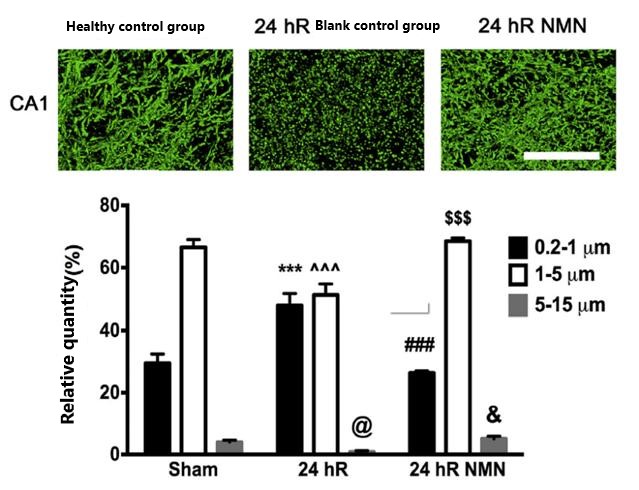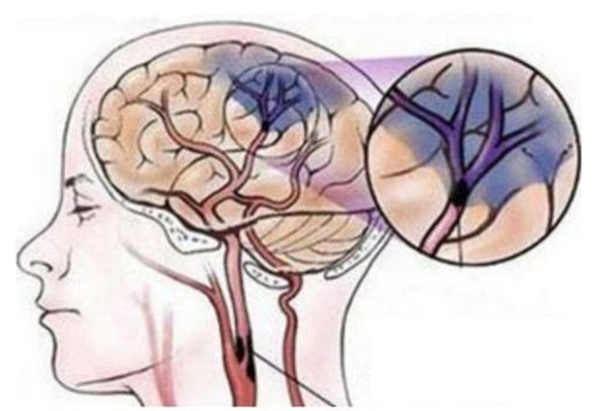University of Maryland, USA: NMN reduces ischemic brain injury in mice
We may have met such patients in life, although they can still maintain basic daily activities, but some of the functions of the body have obvious defects, such as hands and feet, slurred speech and so on.
Such patients are likely to have experienced the process of cerebral ischemia due to atherosclerosis and other reasons, resulting in damage to brain areas corresponding to function.
Previous studies have shown that the level of NAD+ (nicotinamide adenine dinucleotide) in nerve cells after ischemia will rapidly decline, resulting in the inability of mitochondria in cells to synthesize enough “energy currency” ATP (adenosine triphosphate), which will seriously hinder the normal physiological process of cells, and gradually lead to cell apoptosis.
Researchers at the University of Maryland in the United States found that injecting NMN (niacinamide mononucleotide), the direct precursor of NAD+, into mice can effectively deal with brain damage caused by short-term acute ischemia.
The study was published in March 2020 in the journal Experimental Neurology.
In the experiment, the researchers first slightly clamped both sides of the mice’s common carotid arteries with microvascular clips, blocking most of the blood flow to the mice’s brains.
After 10 minutes, the microvessel clamp was removed and the mice’s brains began to return to normal blood supply. After another 30 minutes, the researchers gave the mice a one-time injection of 62.5mg/kg (equivalent to about 280mg in humans) of NMN in the abdominal cavity.
The results showed that after 10 minutes of ischemia, the mitochondrial NAD+ level in the hippocampus of mice continued to decline for 24 hours.
The injection of NMN significantly reversed this, with levels gradually returning to normal within 24 hours.

In addition, NMN prevents mitochondrial division caused by ischemia.
According to previous research, when mitochondria are exposed to external damage and are in an “unfavorable” environment, they will first split into smaller forms and then gradually “disintegrate” 1.
In the experiment, the researchers observed the mitochondrial morphology of CA1 cells in the mouse brain by fluorescence chromography technology. It found that 24 hours after ischemia and recovery, the mitochondria of mice without NMN injection had large-scale division, and the short mitochondria of 0.2-1μm increased significantly, while the long mitochondria of 5-15μm almost disappeared.
In contrast, NMN did a good job of maintaining the morphological integrity of mitochondria, making them indistinguishable from healthy controls.

Through further experiments, the researchers found that the process by which NMN responds to ischemic brain injury is closely related to the role of SIRT3 protein.
This protein can only play a role in regulating cell physiological processes with the help of NAD+, and when the researchers knocked out the gene expressing the SIRT3 protein, NMN’s protective effect against ischemic brain injury disappeared.
In summary, this experiment found that NMN can effectively alleviate the damage caused by short-term acute ischemia to the brain, especially in maintaining the morphology and function of mitochondria in nerve cells.
In addition, the treatment process of NMN is very convenient, only a one-time low dose (62.5mg/kg) injection can work.
Combined with the research results of Rutgers University in the United States on the treatment of myocardial infarction reperfusion injury in 2014, 3 May mean that NMN has the opportunity to appear in the rehabilitation of myocardial infarction and cerebral infarction patients in the future.
References:
- 1. Kleele, T., Rey, T., Winter, J., Zaganelli, S., Mahecic, D., Perreten Lambert, H., Ruberto, F. P., Nemir, M., Wai, T., Pedrazzini, T., & Manley, S. (2021). Distinct fission signatures predict mitochondrial degradation or biogenesis. Nature, 593(7859), 435–439.https://doi.org/10.1038/s41586-021-03510-6
- 2. Klimova, N., Fearnow, A., Long, A., & Kristian, T. (2020). NAD+ precursor modulates post-ischemic mitochondrial fragmentation and reactive oxygen species generation via SIRT3 dependent mechanisms. Experimental neurology, 325, 113144. https://doi.org/10.1016/j.expneurol.2019.113144
- 3. Yamamoto, T., Byun, J., Zhai, P., Ikeda, Y., Oka, S., & Sadoshima, J. (2014). Nicotinamide mononucleotide, an intermediate of NAD+ synthesis, protects the heart from ischemia and reperfusion. PloS one, 9(6), e98972. https://doi.org/10.1371/journal.pone.0098972




